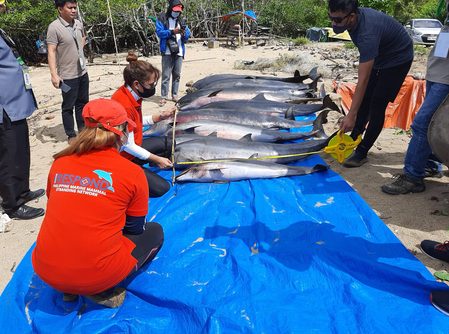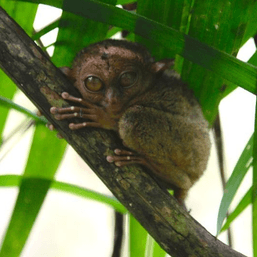SUMMARY
This is AI generated summarization, which may have errors. For context, always refer to the full article.

Unabated illegal fishing, particularly blast fishing which use dynamites, in the waters of Bicol was what killed the 14 out of 25 Fraser’s dolphins stranded in the municipality of Del Gallego, Camarines Sur last month.
This was conclusion of the Philippine Marine Mammal Stranding Network (PMMSN) and the Bureau of Fisheries and Aquatic Resources officials said.
In a joint statement Friday, Dr Lemnuel Aragones, PMMSN president, and Nonie Enolva, spokesperson of the Bureau of Fisheries and Aquatic Resources (BFAR) in Bicol, said that based on their necropsy on the 14 carcasses, the dolphins (Lagenodelphis hosei) died due to severe environmental force or impact of exploding dynamite used in blast fishing.
They said that the post mortem examination revealed the following in most of the specimens: edema and congestion of the lungs, hemorrhages on the meninges of the brain, pale streaks on skeletal and cardiac muscles, and edema and dark discoloration of the kidneys.
“The necropsy diagnosis was exertional myopathy due to the stranding event. The cause of the stranding is most likely due to an acute and forceful impact because the animals were apparently in good body condition,” Aragones and Enolva said.
“Therefore, we suspect that a sudden but severe environmental force such as dynamite blasts most likely caused the animals to flee and become disoriented and literally stressed to death,” the joint statement said.
Other findings were mild gastric ulcers and parasitism, but these may not have caused their deaths, they said.
Samples were taken for further testing by the Marine Mammal Research and Stranding Laboratory of UP IESM, including tissues for histopathology.
The mass stranding of 25 Fraser’s dolphins of varying ages happened on January 26 in Barangay Magais 1, Del Gallego, Camarines Sur.
Twelve were found floating and released back to the wild on the same day. Unfortunately, one dolphin, most likely re-strander, beached dead the following day in the same area.
All 14 carcasses were necropsied on January 27.
Ragay Gulf is considered a “hot spot” for blast fishing, Enolva said.
Enolva said that the 25 Fraser sea mammals were the first stranded cases this year.
“We are hopeful that the Ragay Gulf Management and Development Council with the local chief executives as members as headed by Pasacao Mayor Nino Tayco and the BFAR 5 would lobby for more stringent law enforcement within the municipal waters to protect marine mammals and other aquatic resources in the Gulf,” the PMMSN official said.
Records of the PMSN show a high prevalence of mass stranding in Bicol due to illegal fishing practices (blast fishing) for the past years, making the region a “hot spot” for stranding dolphins.
Last year, at least 15 melon-headed whales (Peponocephala electra) were found dead in Catanduanes on October 8, 2020 following their mass stranding in the province’s coastal waters.
The 15 are part of a pod of about 70 melon-headed whales that were stranded in a mangrove area in San Andres town, and had been monitored in another coastal area of the town.
Enolva said then that the 15 melon-headed whales found dead in Catanduanes were also caused by blast fishing within the Lagonoy Gulf and Maqueda Channel. Maqueda Channel is located within the areas of Caramoan, Presentacion in Camarines Sur, and Catanduanes, the vast fishing ground in the area. Enolva said that dolphins are an endangered species and are vital to maintain the balance of the marine ecosystem as they are apex predators.
Currently, Enolva said that a pod of dolphins is in Ticao-Burias-Pass to Ragay Gulf because of the abundance of sardines (Sardinelia lemuru) locally called here as lawlaw or tamban. – Rappler.com
Add a comment
How does this make you feel?











There are no comments yet. Add your comment to start the conversation.